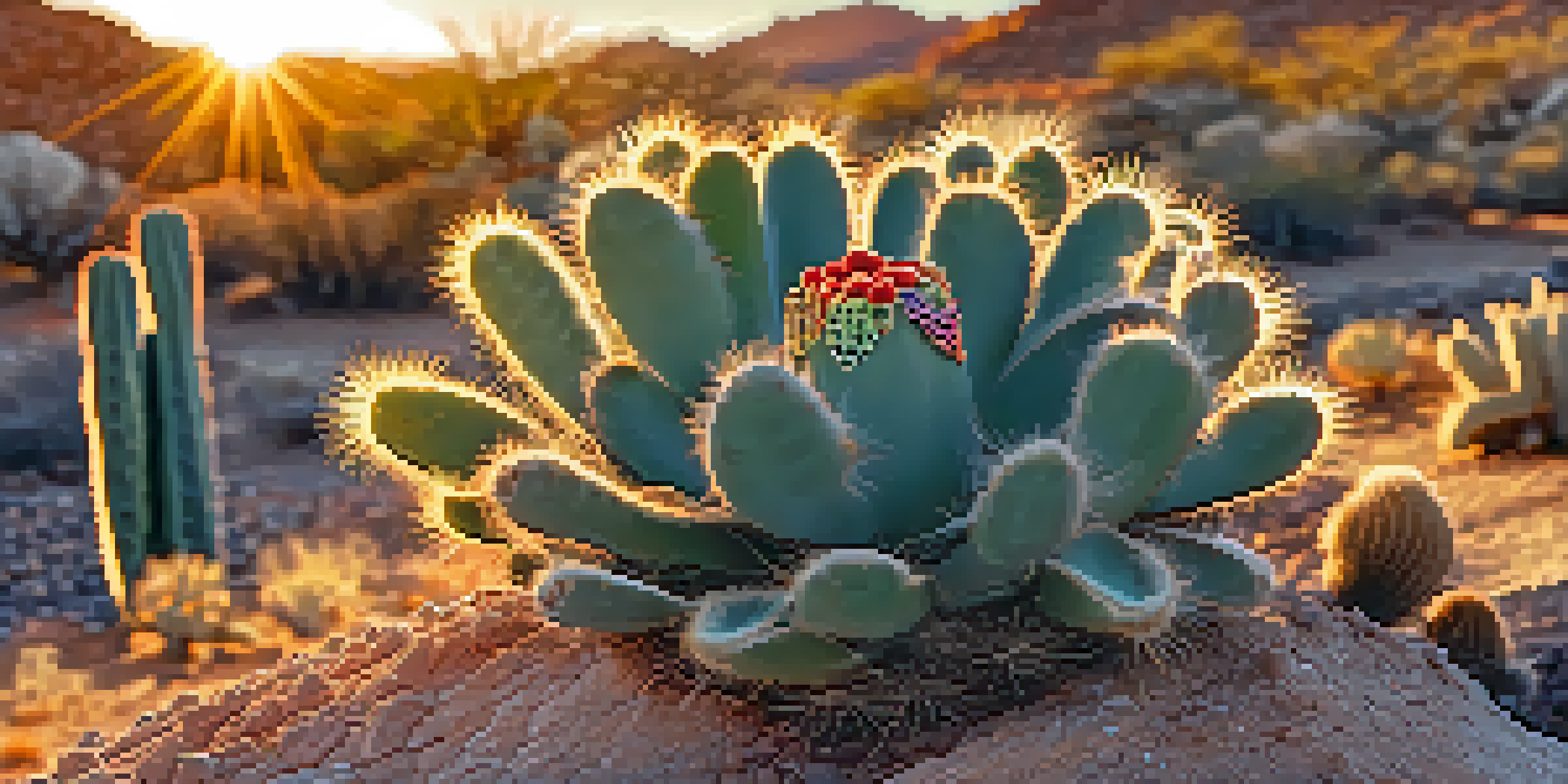The Journey of Peyote: From Indigenous Roots to Global Use

Understanding Peyote: The Plant and Its Significance
Peyote is a small cactus native to the southwestern United States and northern Mexico, known for its psychoactive properties. Traditionally, indigenous peoples have revered peyote, using it in religious and spiritual ceremonies for thousands of years. The cactus contains mescaline, a substance that alters perception and consciousness, making it central to various rituals.
The medicine of the future is the medicine of the past.
For Native American tribes, peyote is more than just a plant; it embodies a deep connection to their heritage and spirituality. It is often consumed in a ceremonial setting, where its effects are believed to facilitate communication with the divine. This sacred use highlights the cultural significance of peyote, distinguishing it from recreational drug use.
As the global interest in psychedelics has grown, so has the curiosity about peyote and its traditional uses. However, it's essential to respect its origins and the communities that have relied on it for spiritual guidance. This understanding lays the groundwork for exploring peyote's journey from indigenous roots to broader recognition.
Historical Context: Peyote in Indigenous Cultures
The use of peyote dates back thousands of years, with evidence suggesting it has been used in rituals since at least 5000 BCE. Various indigenous groups, including the Huichol and the Navajo, have incorporated peyote into their spiritual practices, utilizing it for healing and vision quests. These practices are deeply embedded in their cultural identity, showcasing the cactus's integral role in their traditions.

Throughout history, peyote has served as a bridge between the physical and spiritual worlds for many tribes. Ceremonies often involve elaborate rituals, music, and prayer, creating a sacred space for participants to connect with their ancestors and the universe. This highlights the importance of community and shared experience in indigenous cultures.
Peyote's Cultural Significance
Peyote is deeply revered by indigenous peoples, serving as a vital part of their spiritual practices and cultural identity.
However, the arrival of European settlers brought significant challenges to these traditional practices. The misunderstanding and stigmatization of peyote led to attempts to suppress its use, forcing indigenous peoples to navigate their identities and spirituality in a rapidly changing world. Despite these challenges, the resilience of these cultures has allowed the practice to endure.
The Peyote Road: Its Spread Beyond Indigenous Communities
As the 20th century unfolded, interest in peyote began to extend beyond indigenous communities. The rise of the counterculture movement in the 1960s sparked a renewed fascination with psychedelics, including peyote, among non-indigenous populations. This interest was fueled by a desire for alternative spiritual experiences and an exploration of consciousness.
Cultural appropriation is not just a matter of borrowing; it also involves power dynamics and respect for the original culture.
Psychedelic research also gained traction during this time, with scientists studying the effects of mescaline. This academic interest opened doors for discussions about the therapeutic potential of peyote, though it often overlooked the cultural significance of its traditional use. Many began to recognize peyote not just as a substance but as a symbol of deeper spiritual exploration.
However, this spread has not come without controversy. The commodification of peyote raises ethical concerns about cultural appropriation and the potential harm to indigenous practices. As more people seek out peyote experiences, it’s crucial to foster respectful relationships with the communities that have safeguarded its sacred use for generations.
Legal Challenges: Peyote's Status in Modern Society
The legal status of peyote varies significantly around the world, creating a complex landscape for its use. In the United States, peyote is classified as a Schedule I controlled substance, making its use illegal except for recognized religious ceremonies by the Native American Church. This legal framework aims to protect traditional practices, but it also complicates access for those outside these communities.
Internationally, the legal perspective on peyote can differ greatly, with some countries recognizing its cultural significance while others enforce strict prohibitions. This disparity highlights the ongoing tension between indigenous rights and broader societal interests. The challenge lies in balancing the protection of traditional practices with the desire for broader access to peyote's benefits.
Legal Challenges of Peyote Use
The legal status of peyote varies worldwide, often restricting its use to recognized religious ceremonies while complicating access for broader therapeutic exploration.
As the conversation surrounding psychedelics continues to evolve, advocates argue for a re-examination of peyote's legal status. They emphasize the need for policies that respect indigenous traditions while also acknowledging the growing interest in its therapeutic potential. This ongoing dialogue is essential in shaping the future of peyote within both indigenous and global contexts.
Psychedelic Renaissance: Modern Research and Peyote
The recent resurgence of interest in psychedelics, often referred to as the 'psychedelic renaissance,' has brought renewed attention to peyote. Researchers are exploring its potential therapeutic applications, particularly in mental health treatment, including anxiety, depression, and PTSD. This research aims to validate what many indigenous cultures have known for centuries: that peyote can facilitate profound healing experiences.
Studies suggest that mescaline, the active compound in peyote, may promote neuroplasticity, helping the brain form new connections. This scientific validation can pave the way for a deeper understanding of peyote's benefits and its role in traditional healing practices. However, it's vital that such research is conducted ethically and in collaboration with indigenous communities.
As interest grows, there is a pressing need to ensure that the benefits of peyote are shared equitably. Ethical considerations must take center stage to honor the cultural significance of the cactus while exploring its modern applications. This balance is crucial to ensure that indigenous voices remain integral to the conversation surrounding peyote's future.
Cultural Appropriation vs. Appreciation: Navigating the Divide
As peyote gains popularity among non-indigenous users, discussions around cultural appropriation have become increasingly pertinent. Many indigenous peoples express concern that the commercialization of peyote undermines its sacred significance and commodifies their culture. Understanding the difference between appreciation and appropriation is essential for fostering respectful engagement with this powerful plant.
Cultural appropriation occurs when elements of one culture are adopted by another without understanding or respect for their significance. In contrast, appreciation involves a genuine respect for the culture, often including collaboration and acknowledgment of its origins. As more people seek to engage with peyote, it’s essential to approach it with humility and a willingness to learn from those who have preserved its traditions.
Ethics of Peyote's Modern Interest
The rise in non-indigenous interest in peyote raises concerns about cultural appropriation and emphasizes the need for respectful engagement with its traditional significance.
Creating spaces for dialogue between indigenous communities and those interested in peyote can foster mutual respect and understanding. Encouraging education about the cultural context of peyote can help bridge the divide, ensuring that its use honors its roots while exploring its potential benefits. Ultimately, this approach nurtures a more inclusive conversation about peyote's place in both indigenous and global contexts.
The Future of Peyote: Balancing Tradition and Modern Use
Looking ahead, the future of peyote hinges on finding a balance between honoring its traditional use and exploring its modern applications. As interest in psychedelics grows, it is crucial to involve indigenous voices in shaping the narrative around peyote. This partnership can ensure that traditional practices are respected while exploring the plant's potential benefits.
Ongoing research may reveal new therapeutic uses for peyote, but these developments must be approached with care and respect for the cultural context. Engaging indigenous communities in the research process can help safeguard their traditions while facilitating responsible exploration of peyote's properties. This collaboration can also empower indigenous peoples, giving them a voice in the future of their sacred plants.

Ultimately, the journey of peyote from indigenous roots to global use presents both challenges and opportunities. By fostering respectful dialogue and collaboration, we can navigate this complex landscape together, ensuring that peyote continues to be a source of healing and connection for generations to come.